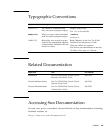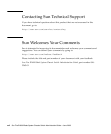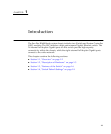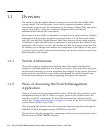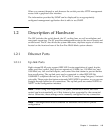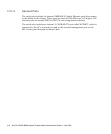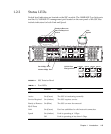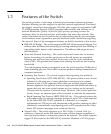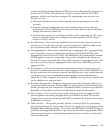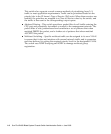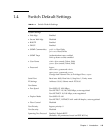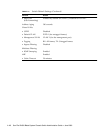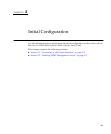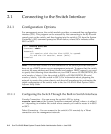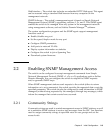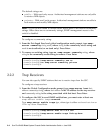
Chapter 1 Introduction 1-7
can be dynamically learned through GVRP or ports can be manually assigned to a
specific set of VLANs. This allows the switch to restrict traffic to the VLAN
groups to which a user has been assigned. By segmenting your network into
VLANs, you can:
■ Eliminate broadcast storms, which severely degrade performance in a flat
network.
■ Simplify network management for node changes and moves by remotely
configuring VLAN membership for any port, rather than having to manually
change the network connection.
■ Provide data security by restricting all traffic to the originating VLAN, except
where a connection has been configured between separate VLANs using a
router or Layer 3 switch.
■ Port Mirroring – The switch can unobtrusively mirror traffic from any port to a
monitor port. You can then connect a protocol analyzer or RMON probe to this
port to perform traffic analysis and verify connection integrity.
■ Link aggregation – Ports can be combined into an aggregate link. Aggregate links
can be manually set up or dynamically configured using IEEE 802.3ad Link
Aggregation Control Protocol (LACP). The additional ports dramatically increase
the throughput across any connection, and provide redundancy by taking over
the load if a port in the trunk fails. The switch supports six aggregated links, with
up to four up-link ports per aggregated link or up to two down-link ports per
aggregated link.
■ Port Security – Port security prevents unauthorized users from accessing your
network. It enables each port to learn, or be assigned, a list of MAC addresses for
devices authorized to access the network through that port. Any packet received
on the port must have a source address that appears in the authorized list,
otherwise it will be dropped. Port security is disabled on all ports by default, but
can be enabled on a per-port basis.
■ Broadcast Suppression – Broadcast suppression prevents broadcast traffic from
overwhelming the network. When enabled on a port, the level of broadcast traffic
passing through the port is restricted. If broadcast traffic rises above a pre-defined
threshold, it is throttled until the level falls back beneath the threshold.
■ Flow Control – Flow control reduces traffic during periods of congestion and
prevent packets from being dropped when port buffers overflow. The switch
supports flow control based on the IEEE 802.3x standard. By default, flow control
is disabled on all ports.
■ Traffic Priority – This switch provides Quality of Service (QoS) by prioritizing
each packet based on the required level of service, using four priority queues with
Weighted Round Robin queuing. The switch uses IEEE 802.1p and 802.1Q tags to
prioritize incoming traffic based on input from the end-station application. These
functions can be used to provide independent priorities for delay-sensitive data
and best-effort data.



